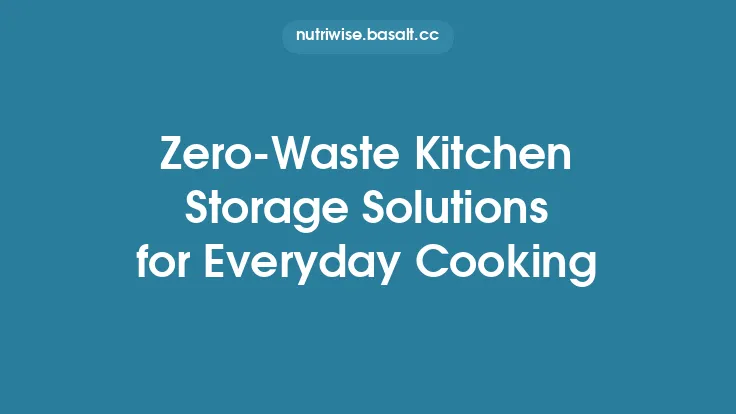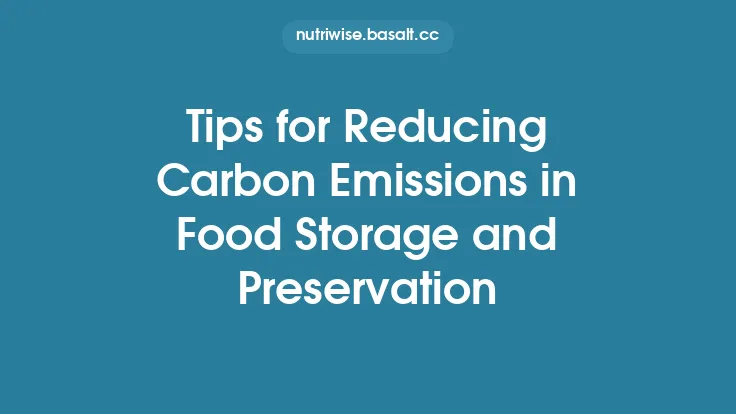Fresh ingredients and leftovers are the lifeblood of any meal‑planning routine. When they’re stored correctly, they retain flavor, texture, and nutritional value, which translates into better meals, less waste, and a smoother cooking experience. Below is a comprehensive guide to smart storage solutions that keep your produce crisp, your proteins safe, and your leftovers ready for the next day—without stepping into the territory of pantry organization, labeling systems, or overall kitchen layout.
Understanding the Needs of Fresh Produce
1. Moisture Management
- High‑humidity environments (e.g., leafy greens, herbs) thrive in drawers that maintain 95‑100 % relative humidity.
- Low‑humidity environments (e.g., onions, garlic, mushrooms) stay fresh longer when kept at 65‑70 % humidity.
2. Ethylene Sensitivity
- Some fruits (apples, bananas, avocados) emit ethylene gas, which accelerates ripening in nearby vegetables. Store ethylene‑producing items separately or in ethylene‑absorbing containers to prevent premature spoilage.
3. Temperature Zones
- Root vegetables (carrots, potatoes, beets) prefer cooler, but not freezing, temperatures (32‑40 °F).
- Berries are best kept just above freezing (32‑35 °F) to slow mold growth.
Understanding these variables lets you match each food type to its optimal storage micro‑environment.
Choosing the Right Containers for Different Food Types
| Food Category | Ideal Container | Key Features |
|---|---|---|
| Leafy greens & herbs | Perforated, breathable produce bags or reusable mesh produce bags | Allows airflow while retaining moisture |
| Berries & delicate fruit | Shallow, vented containers with a paper towel liner | Absorbs excess moisture, reduces crushing |
| Cut vegetables | Airtight, BPA‑free plastic or glass containers with a snap‑lock lid | Prevents oxidation and cross‑contamination |
| Cooked grains & legumes | Stackable, airtight glass jars with silicone seals | Keeps moisture out, easy to label (if needed) |
| Soups & stews | Vacuum‑seal bags or freezer‑grade silicone bags | Saves space and prevents freezer burn |
| Cheese & cured meats | Waxed cheese paper inside a rigid container, or a dedicated cheese dome | Controls humidity while allowing the cheese to breathe |
Material Matters
- Glass: Non‑porous, doesn’t stain, ideal for acidic foods.
- Stainless steel: Durable, lightweight, and often comes with magnetic lids for fridge organization.
- Silicone: Flexible, freezer‑safe, and collapsible for space‑saving storage.
- High‑density polyethylene (HDPE): Strong, BPA‑free, and resistant to odors.
Temperature and Humidity Management
Built‑In Fridge Drawers
Modern refrigerators often feature crisper drawers with adjustable humidity sliders. Set the “high” setting for vegetables that wilt (lettuce, broccoli) and the “low” setting for produce that prefers a drier environment (apples, mushrooms).
External Humidity Controllers
If your fridge lacks adjustable drawers, consider a small, battery‑powered hygrometer placed inside the produce compartment. Pair it with a reusable humidity pack (e.g., silica gel or calcium chloride) to fine‑tune the environment.
Cold‑Chain Continuity
When transporting fresh produce from the grocery store to home, use insulated grocery bags with a thin layer of ice packs. This keeps the temperature stable for the first 2‑3 hours, reducing the risk of early spoilage.
Vacuum Sealing and Sous‑Vide‑Style Storage
Why Vacuum Seal?
- Extended Shelf Life: Removing air slows oxidation and microbial growth, adding 2‑3 weeks to many fresh items.
- Space Efficiency: Flattened bags stack neatly, freeing up valuable fridge or freezer real estate.
- Flavor Preservation: Sealed environments lock in aromas, especially useful for herbs and marinated proteins.
Best Practices
- Pre‑Freeze Liquids: When sealing soups or sauces, chill them first; this prevents the vacuum pump from sucking liquid out.
- Use Food‑Safe Bags: Look for BPA‑free, freezer‑grade polyamide/polyethylene bags rated for at least –40 °F.
- Avoid Over‑Compression: For delicate items like berries, use a “gentle” vacuum setting or a “pulse” mode to prevent crushing.
Sous‑Vide‑Style Storage
If you own a sous‑vide circulator, you can store pre‑seasoned proteins in vacuum bags at refrigerator temperatures (40 °F) for up to 5 days. This pre‑marination reduces prep time and ensures even flavor distribution.
Smart Containers and IoT‑Enabled Solutions
Sensor‑Embedded Containers
- Temperature Sensors: Bluetooth‑enabled lids alert you via a smartphone app if the contents exceed safe temperatures.
- Humidity Sensors: Some containers display real‑time humidity levels, prompting you to adjust drawer settings.
- Expiration Tracking: Integrated QR codes or NFC tags can be scanned to log purchase dates, automatically calculating “best‑by” alerts.
Power Considerations
Most smart containers run on replaceable coin cells lasting 6‑12 months, or rechargeable lithium‑ion batteries that can be charged via USB‑C. Ensure the device’s firmware is regularly updated for accurate sensor calibration.
Data Integration
If you use a meal‑planning app, many smart containers can sync with it, automatically moving items from a “shopping list” to a “pantry inventory” once scanned. This creates a seamless loop from purchase to consumption without manual entry.
Layered Storage Strategies for Leftovers
1. The “Flat‑First” Method
When storing leftovers, lay them flat in a shallow container before sealing. This speeds up cooling, reduces the risk of bacterial growth, and makes reheating more even.
2. Portion‑Control Compartments
Invest in multi‑compartment containers (e.g., 3‑section lunch boxes). Allocate each compartment to a different component of a meal—protein, grain, vegetable—so you can reheat only what you need.
3. Stack‑Ready Freezer Bins
Use rigid, stackable freezer bins with clear lids. Label the top of each bin with a dry‑erase marker for quick identification. This system prevents “freezer avalanche” where items get buried and forgotten.
4. “One‑Week” Rotation
Designate a “first‑in, first‑out” shelf in your fridge for leftovers. Place the newest items at the back and older ones at the front, ensuring you consume them within a safe window (typically 3‑4 days for most cooked foods).
Batch‑Prep Friendly Storage Systems
Batch‑Cooked Grains
- Cook a large batch of quinoa, brown rice, or farro. Cool quickly on a sheet pan, then portion into individual zip‑top bags. Freeze flat for easy grab‑and‑go servings.
Pre‑Portioned Protein Packs
- Marinate chicken breasts, tofu cubes, or fish fillets in vacuum bags. Store each bag in a single‑serve portion size, ready for direct cooking from the fridge or freezer.
Vegetable “Mirepoix” Kits
- Dice onions, carrots, and celery in bulk. Store each component in separate airtight containers, then combine as needed. This reduces prep time for soups, stews, and sauces.
Herb Ice Cubes
- Blend fresh herbs with a little water or oil, pour into silicone ice‑cube trays, and freeze. Transfer the frozen cubes to a zip‑top bag for quick flavor boosts without wilting fresh herbs.
Maintaining Food Quality Over Time
Regular Audits
- Conduct a quick visual and olfactory check of stored items every 3‑4 days. Discard anything showing signs of mold, off‑odors, or excessive moisture.
Re‑Sealing After Opening
- Even airtight containers can lose their seal after repeated opening. Use a fresh silicone gasket or a new zip‑top bag if the seal feels compromised.
Defrosting Protocol
- For frozen leftovers, move them to the refrigerator 12‑24 hours before use. This gradual thaw preserves texture and reduces the risk of bacterial growth compared to rapid microwave defrosting.
Avoid Overcrowding
- Air circulation is essential for temperature stability. Leave a small gap between containers in the fridge and freezer to allow cold air to flow freely.
Cleaning and Maintenance of Storage Tools
Glass and Stainless Steel
- Wash in warm, soapy water and dry immediately to prevent water spots. For stubborn stains, a mixture of baking soda and water works well.
Silicone Bags
- Rinse with hot water and a mild detergent. For odor removal, soak in a solution of 1 part white vinegar to 4 parts water for 15 minutes, then rinse thoroughly.
Vacuum Sealer Heads
- Wipe the sealing strip after each use with a damp cloth. Periodically run a “clean cycle” (most modern sealers have this function) using a small amount of distilled water to clear any residue.
Smart Container Batteries
- Replace coin cells when the app indicates low power. Keep a spare set of batteries on hand to avoid downtime.
Putting It All Together: A Practical Storage Workflow
- Unpack with Intent
- Immediately sort produce into high‑ and low‑humidity groups. Place ethylene‑producing fruits in a separate drawer or container.
- Select the Appropriate Container
- Match each item to its ideal storage vessel (mesh bag for greens, vented tray for berries, airtight glass for cooked grains).
- Set Fridge Conditions
- Adjust humidity sliders, place hygrometers, and ensure temperature stays between 35‑38 °F for most perishables.
- Seal and Label (if needed)
- Use vacuum sealing for items you plan to store longer than a week. If you prefer a visual cue, a simple dry‑erase marker on the container lid works without creating a full labeling system.
- Log in Your Meal‑Planning App
- Scan smart containers or manually input the date of storage. Set reminders for “use by” dates.
- Rotate Regularly
- Follow the “first‑in, first‑out” principle for leftovers and pre‑pped ingredients. Perform a quick audit every few days.
- Clean and Reset
- At the end of each week, wash reusable containers, check seals, and replace any worn components.
By integrating these smart storage solutions into your routine, you’ll keep fresh ingredients vibrant, leftovers safe, and your meal‑planning process streamlined—without the need for extra tools, elaborate labeling schemes, or a complete kitchen redesign. The result is a kitchen that works for you, day after day, season after season.





